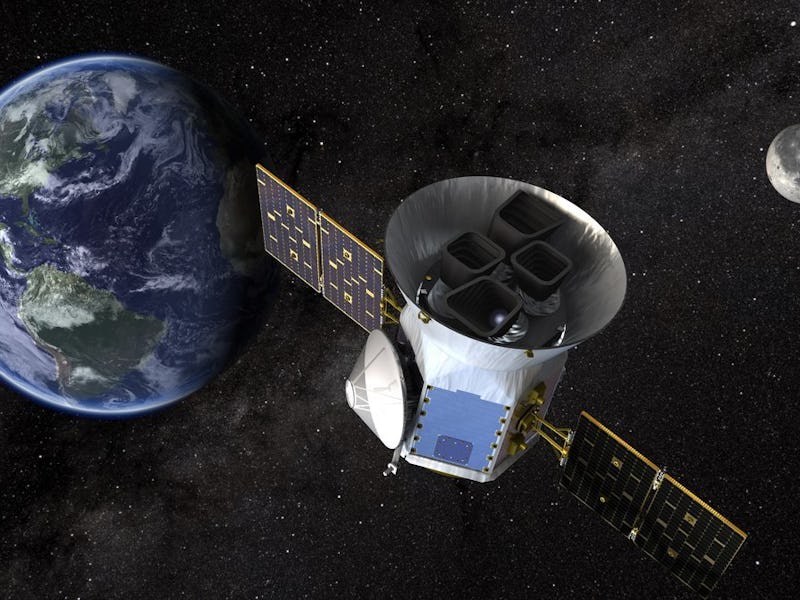Next Wave of Exoplanet Searches Could Spot Alien Vegetation
And forget exoplanets, how about exomoons?

Just 25 years ago, the existence of planets in other solar systems was a topic of debate. Now, we’ve discovered more than 3,500 exoplanets, and many of those are the work of NASA’s Kepler space observatory, which spotted thousands of planets in solar systems’ habitable zones during its survey of one particular slice of our galaxy. The next step will be to find exoplanets close enough that we can observe them in unprecedented detail, right down to even what kind of plants might be growing on their surface.
NASA scientists Jeff Volosin and Matt Ritsko were on hand Sunday at the Star Trek: Mission New York event to discuss the project they’re leading, the Transiting Exoplanet Survey Satellite. Kepler proved there are more planets than stars in our galaxy, and TESS hopes to take a closer look at what’s out there.
“Now we’re taking the next step of saying, ‘Okay, we know planets are plentiful, we need then to target closer to Earth to find ones that are interesting,’” Ritsko told Inverse after the panel. While TESS, set to launch in December 2017 and operate for two years, is a relatively small mission by NASA standards, its painstaking observation of other solar systems will allow another satellite to make far more detailed observations. The James Webb Space Telescope will go up in October 2018 as a far more powerful successor of the Hubble. The new telescope would be powerful enough to detect the specific spectrums of electromagnetic radiation coming off of exoplanets.
“The plan then is that Webb could have the technology with infrared to follow up on spectrums of exoplanets,” Ritsko told Inverse. “So we will point them out for Webb. That way we don’t have to sleuth to look for a target. If you find that target that’s really interesting, a rocky world around a star that’s relatively nearby, that would be interesting for it to follow up on.”
“If you stared at the Earth from Voyager distance… you could tell if there’s wheat growing or whether there’s a forest of birch trees.”
And what sorts of things could Webb tell us from observing exoplanets? During the panel, Volosin used a photo of Earth taken by one of the Voyager probes as it sped ever deeper into the outer reaches of the solar system.
“So if you stared at the Earth from Voyager distance, you could look at the spectrum of the Earth,” Volosin explained. “And freakishly, not only could you tell that there’s hydrogen and nitrogen and methane or carbon dioxide, you could even tell if there’s vegetation. Because vegetation will absorb and emit in certain parts of the spectrum. You could tell if there’s wheat growing or whether there’s a forest of birch trees. You could tell whether they’re immature, you could tell if they’re mature.” That astounding level of detail comes just by looking at what wavelengths of light are coming off the exoplanet, and it could even point to the presence of intelligent life on other worlds — always assuming any is out there, of course.
“Some spectrum can also tell if there’s a large methane contribution in the planet’s atmosphere, like livestock,” Ritsko said during the panel. “So some scientists are postulating that the Earth has so much methane because we’re using livestock, so if you see that on another planet, that might mean there’s some form of life using another form of life.”
Not every planet TESS locates in a star’s habitable zone will be a rocky, Earth-like planet. But even gas giants aren’t a dead end in the search for potentially habitable worlds.
“Even when we find these gas giant planets that are in the habitable zone of a star we’re looking at, it doesn’t necessarily mean there’s not life there, because that planet could have a moon around it,” Ritsko said. “And if that gas giant has a magnetosphere, that would protect the moon from radiation, so life there could form easily on a moon of one of those planets.”
While exomoons would be even harder to detect than exoplanets — after all, the smaller something is, the harder it will be to spot — Ritsko says the technology could soon be precise enough to spot even those tiny satellites. In the meantime, the more we can learn about potentially habitable moons in our own solar system, the more we can say about those around exoplanets.
“If that gas giant has a magnetosphere, that would protect the moon from radiation, so life there could form easily on a moon of one of those planets.”
“It adds more attention on missions like Juno that’s currently studying Jupiter,” Ritsko told Inverse. “Because if we understand the magnetosphere of Jupiter and how it interacts with its moons, you can start postulating and using the kind of data and models for extrasolar planets.” A deep understanding of gas giants’ magnetospheres would be particularly important, because they are likely crucial to the habitability of the planets’ moons.
“We don’t have the technology yet to detect whether a giant exoplanet like a Jupiter size, does it have a magnetosphere,” Ritsko explained. “We’re not there yet. But if you understand could there be a magnetosphere around it that would protect it from radiation, and that’s where your thoughts on habitability then change.”